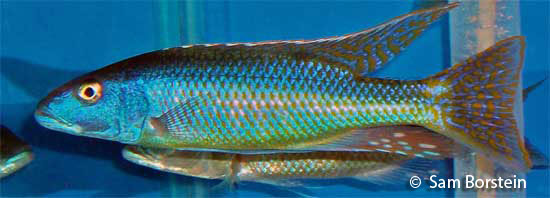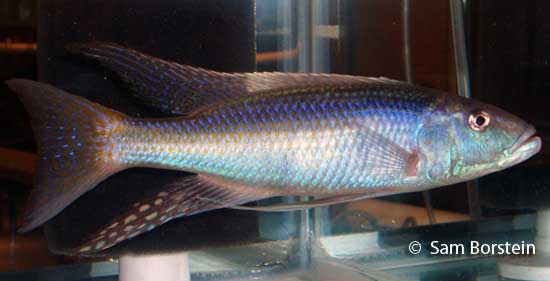Champsochromis caeruleus
(Boulenger, 1908)
Malawi Trout Cichlid

Above: A male Malawi Trout. Photo by Sam Borstein.
Etymology:
Genus- Champso= crocodile (Greek) Referring to snout of fish, chromis= a fish, perhaps a perch (Greek).
Species- caeruleus= blue (Latin).
Intro:
Champsochromis caeruleus is a piscivorous maternal mouthbrooder from Lake Malawi. This fish, first typed by Boulenger in in 1908, is nicknamed the Trout Cichlid because of the similarity in body shape and swimming style. There are two species of Champsochromis: Champsochromis caeruleus and Champsochromis spilorynchus. Only Champsochromis caeruleus is readily available.
The Malawi Trout Cichlid is one of the largest and pretties Malawian cichlids in the hobby. Males are a magnificent blue color and have a red anal fin. The scales on the body range from an orange to red color. The fins on males can be massive, stretching well past the caudal fin, especially in older specimens.
Even though this is one of the largest Malawians, it is peaceful. Because Champsochromis caeruleus is a pursuit predator, it is an active swimmer in the tank, which can sometimes stress fellow tank inhabitants.

Above: A 10-11 inch Champsochromis caeruleus showing the fin extensions older and larger males attain. Photo by Sam Borstein.
Distribution:
Champsochromis caeruleus has a lake-wide distribution in Lake Malawi, and is found in open water and occasionally over sand.
Size, Maturity, and Sexual Dimorphism:
Size: Males- 18 inches, Females- 15 inches
Maturity: 6.5 inches
Sexual Dimorphism: Males are larger than females and are a lot more colorful than the females which are silver with a black horizontal/diagonal line through the body. Older males also develop massive fins, stretching well past the caudal fin.

Above: A female Malawi Trout. Photo by Sam Borstein.
Care:
Caring for Malawi Trout is not very difficult. The most important requirement is to give this active fish a large enough tank, 6 feet or larger. Champsochromis caeruleus likes hard water in the 77-80F degree range.
Because this fish is so large and active, be careful with tank decorations. Make sure you don't use rocks that are to sharp or other objects which could cause injury during a collision.
Diet:
In the wild Champsochromis caeruleus is a pursuit predator and it's favorite activity is dining on Lake Sardine of the Engraulicypris genus (Konings, 2008). In aquaria, they will accept almost any food. I fed mine Spectrum and Tetra Cichlid Sticks. It is impressive to see them track down live food as the pursuit after the prey is lightning fast.
Breeding:
I obtained my Champsochromis caeruleus from fellow GCCA member Mike Helford and placed them in a 75-gallon tank. The fish were young and about two inches long.
At about four inches, my dominant male began to color up and show an interest in spawning. When the male was about six inches, the fish spawned. At this point, I had only had the fish about six months and all accounts I had read indicated that this fish would have to be older to reproduce. I let the female hold assuming that the first spawn would be infertile, or the female would drop. The female held 30 days (Full Term), at which point I stripped her of her eggs.
Before spawning, male Malawi Trout build a Lek, a sand spawning nest. They dig a round hole, usually to the glass of the aquarium. The one my male dug was about a foot long and 10 inches wide. The males during this time intensify color.
For being such a large fish, the spawns are small, only about 35 eggs. However, egg size is very large. Newly free swimming are 3/4 of an inch long!
I preserved some eggs for Dr. Ron Coleman to use in his Cichlid Egg Project. After seeing the eggs, he said they were some of the largest he has seen, especially for a Malawian. Many people I know who have spawned the fish say it is a poor holder and the spawns are small— not my experience.
Fry are easy to raise, but can be over fed. Don't feed too much baby brine, and try to wean the fish to flakes as soon as you can. In my experience, this fish grows fast, but at the 2 inch range, they grow much slower. At about 3.5-4 inches, growth accelerates.
Conclusion:
Because this fish is supposedly hard to breed, the price of these fish is usually high. This fish you won't find at pet shops, but is readily available from hobbyists and fish farms. This is one of my favorite cichlids I've kept. It is downright beautiful and its activity is fun to watch. This is a fish that I will keep again one day.
References:
- Boulenger, G. A. (1908) Diagnoses of new fishes discovered by Capt. E. L. Rhoades in Lake Nyassa. Annals and Magazine of Natural History, 2, 238-243.
- Konings, A. (2007) Malawi cichlids in their natural habitat. 4th ed., Cichlid Press, El Paso, Texas, 424 pp.
